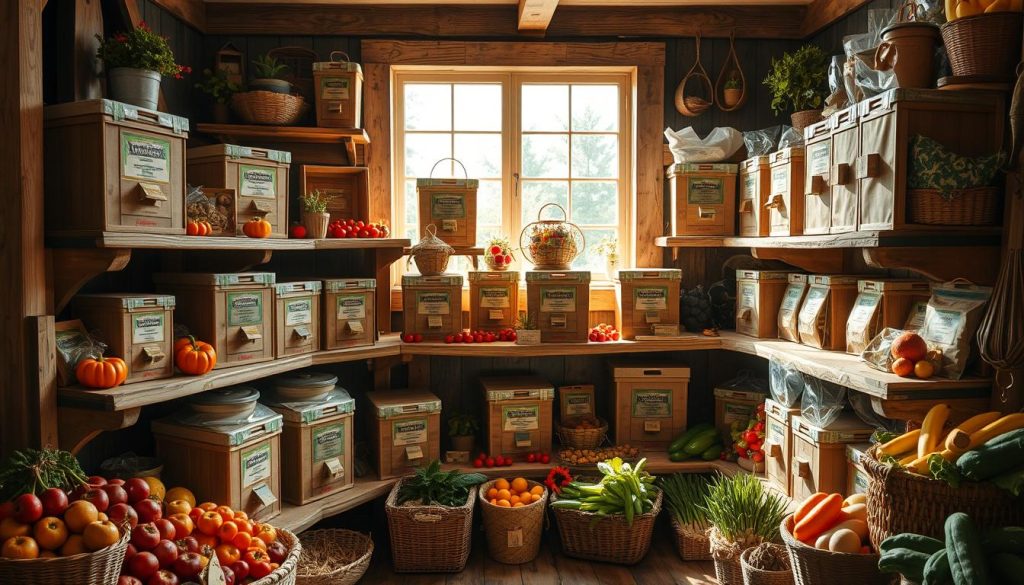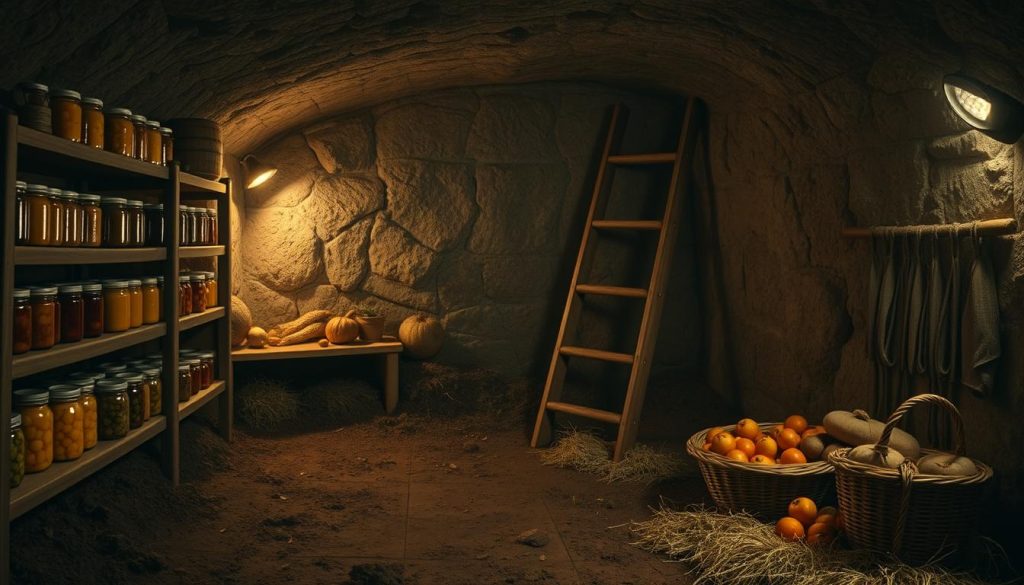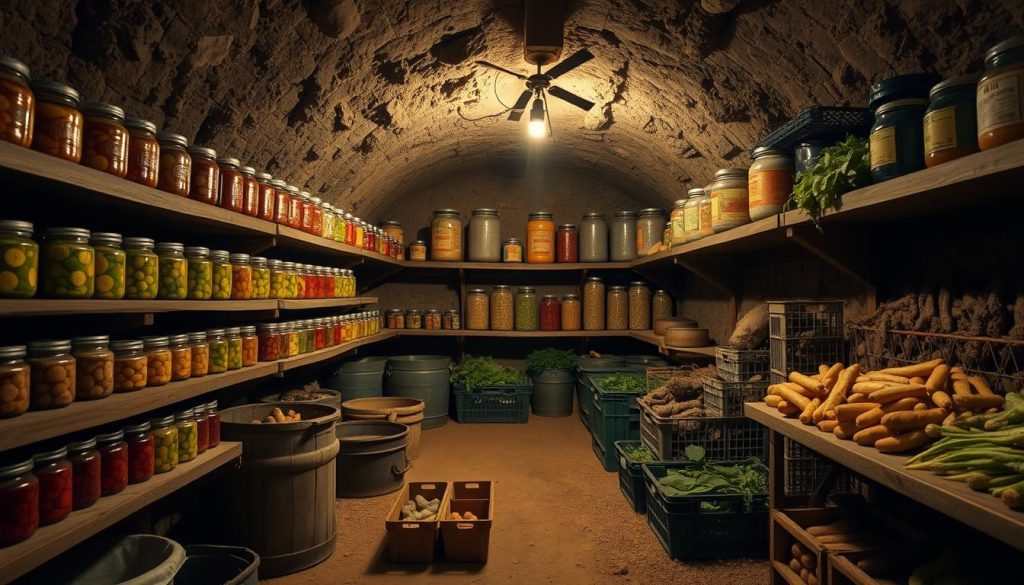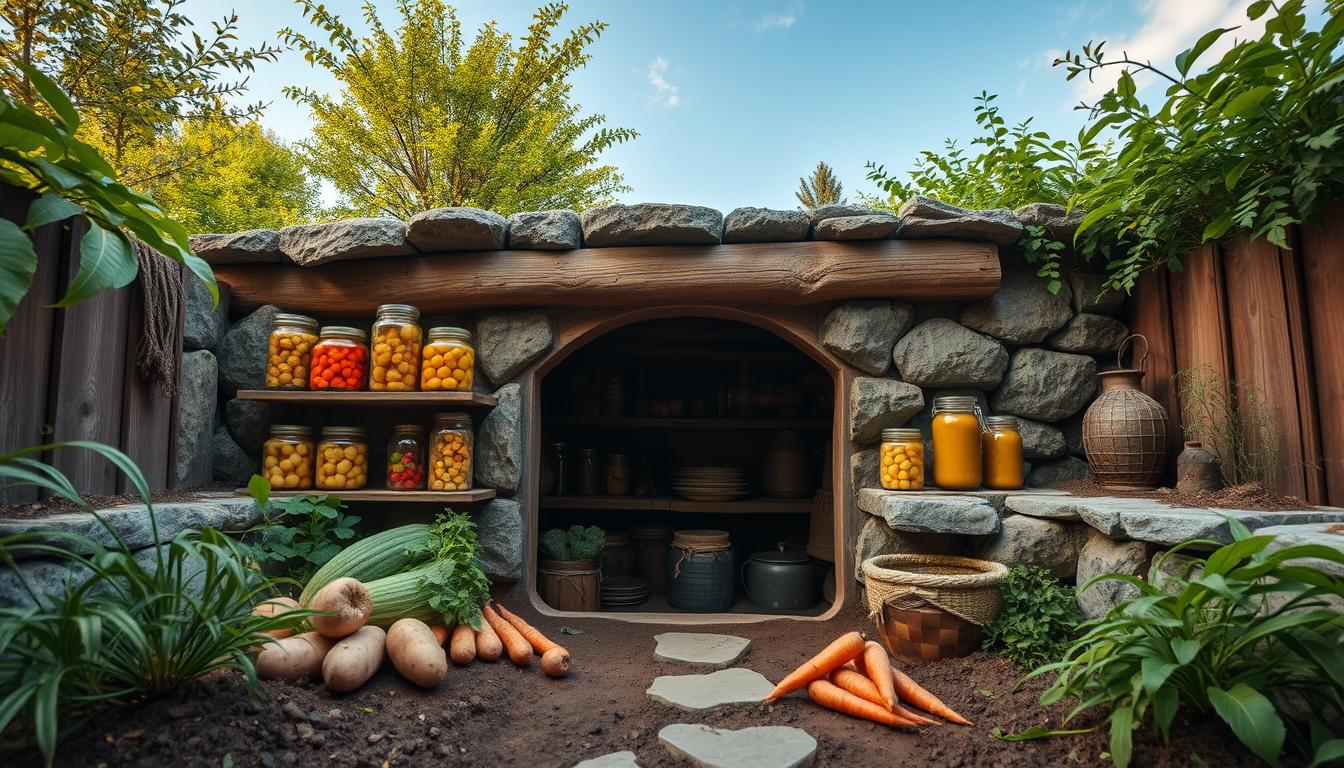More and more people are choosing traditional methods for today’s challenges. Root cellar kits are a top pick for those wanting better home storage and living sustainably.
These kits make it easy to store food underground. They help keep fruits and veggies fresh for longer. With root cellars gaining popularity, it’s clear why these kits are a hit in homes today.
What Are Root Cellar Kits?
Root cellar kits are pre-made or custom packages for building your own root cellar. They use the stable underground temperatures to naturally preserve food. This method has been around for centuries. Now, modern kits make it easy for anyone to start preserving food at home.
Overview of Root Cellar Kits
These kits come with everything you need to build a root cellar. You can choose from pre-made models or DIY kits. They help you store foods like root vegetables and apples. This way, you use the earth’s natural temperature to keep your food fresh, saving energy and promoting self-sufficiency.
Benefits of Using Root Cellar Kits
- Reduced Electricity Dependency: Root cellar kits use the earth’s temperature, cutting down on energy costs.
- Freshness of Produce: They keep fruits and vegetables fresh for longer, ensuring you eat high-quality food year-round.
- Eco-Friendly Preservation: By using less electricity, these kits help you live more sustainably.
- Lower Grocery Bills: Preserving your own food can save you money, especially when prices are high.
How Root Cellar Kits Work
Root cellar kits are smart storage solutions. They use natural cooling and humidity control for the best storage. These kits keep things cool and humid without using electricity, making them good for the environment.
Temperature and Humidity Control
Root cellar kits keep a stable environment. They use the earth’s cool underground temperature all year. They also keep fruits and veggies fresh with high humidity.
These kits have insulation to help control temperature and keep moisture in. This ensures your food stays fresh.
Ventilation Features
Good ventilation is key for a root cellar. These kits have systems for airflow to prevent spoilage. They have air intake and exhaust vents for fresh air and to remove humidity.
The design of the root cellar balances ventilation. This keeps the air inside fresh and good for long storage.
Different Types of Root Cellar Kits
Choosing a root cellar kit can be a big decision. You can pick from prefabricated kits or DIY solutions. Each has its own pros and cons. Knowing these can help you choose the best one for you.
Prefabricated Kits vs. DIY Options
Prefabricated root cellar kits are easy and convenient. They come with all the materials you need and clear instructions. This makes setting them up quick and simple.
- Quick and easy to assemble
- Less labor-intensive
- Standardized quality and safety features
- Often come with warranties
Building a custom root cellar is a rewarding DIY project. It lets you design it exactly how you want. You can choose the materials and layout to fit your needs perfectly.
Benefits of a custom root cellar:
- Total control over design and materials
- Adaptable to unconventional spaces
- Potentially more cost-effective
- Grows skills in DIY construction
Sizing and Space Considerations
Getting the right size for your root cellar is key. A sizing guide can be very helpful here. Prefab kits usually come in standard sizes, making it easy to find one that fits. But, with a custom cellar, you can make it exactly as big as you need.
Think about a few things when deciding on size:
- The amount and type of produce you plan to store
- Your future storage needs
- Available space in your home or yard
- Ease of access and ventilation needs
It’s also important to plan for the future. A sizing guide can help you think about your needs over time. This way, your root cellar will stay useful and efficient as your needs change.
Materials Used in Root Cellar Kits
Building eco-friendly root cellars requires careful material selection. This ensures durability, efficiency, and sustainability. Let’s look at common materials and insulation options.
Common Materials and Their Benefits
Root cellar kits use sustainable materials for better functionality and longevity. Here are some popular choices:
- Concrete: Concrete is strong and durable, making it a top pick for root cellars. It keeps the environment stable.
- Wood: Wood is versatile and sustainable, offering natural insulation and beauty. Proper treatment can extend its life.
- Insulated Panels: These panels provide efficient insulation. They help control temperature and humidity in the root cellar.
Using these materials, manufacturers create root cellar kits that are durable and eco-friendly.
Insulation Options
Insulation is crucial for a root cellar’s success. It keeps the desired climate and saves energy. Here are some common insulation types:
- Foam Insulation: Foam boards block heat transfer well. They have high R-values, making them a favorite for root cellars.
- Spray Foam: This insulation seals gaps and crevices. It keeps the root cellar’s environment consistent.
- Fiberglass Insulation: Fiberglass is affordable and effective. It regulates temperature well, making it great for eco-friendly root cellars.
Choosing the right insulation boosts your root cellar’s performance. It ensures reliable storage for your produce.
Advantages of a Root Cellar
A root cellar brings many benefits to our daily lives. It helps preserve food naturally and stores it for a long time.
Extended Storage Life for Produce
Root cellars are great for keeping fruits and veggies fresh longer. They keep the right temperature and humidity. This makes produce last much longer than usual.
Apples, pears, potatoes, and carrots all do well in a root cellar. It’s a smart way to cut down on food waste. You can enjoy fresh produce all year.
Space Optimization in Your Home
Adding a root cellar to your home is smart for saving space. It’s better than buying extra refrigerators that use a lot of power. Root cellars are a green way to store food.
Using a root cellar makes your kitchen and pantry more free. It’s a clever way to use your home’s space better. Plus, it saves energy by using natural methods to keep food fresh.
Choosing the Right Root Cellar Kit

When picking a root cellar kit, think about a few important things. This root cellar buying guide will guide you through the key features. It will also help you figure out your home food storage requirements.
Key Features to Consider
The right root cellar kit should fit your needs. Look for these key features:
- Size: Choose based on how much produce you’ll store.
- Materials: Go for durable stuff like wood or metal for lasting use.
- Customization Options: Some kits let you add custom shelving and compartments. This is great for different types of produce.
How to Assess Your Needs
To pick the best root cellar kit, think about what you need. Ask yourself these questions:
- What types of produce will you store, and how much?
- What’s your climate like, with temperature and humidity changes?
- How much room do you have for a root cellar?
Knowing these things helps you choose the right root cellar. This way, your home food storage requirements will be met well.
Installation Process of Root Cellar Kits
Setting up a root cellar kit might look hard, but with the right plan and installation guidelines, it’s doable. I’ll guide you through it and point out common mistakes to avoid.
Step-by-Step Installation Guide
- Site Selection: Pick a spot that’s dry and cool naturally. It should be close to your house for easy access.
- Prepare the Ground: Remove any trash and dig as the kit says. This step is key to avoid problems later.
- Construct the Foundation: Build a solid base following cellar construction tips. A concrete pad is best for lasting results.
- Assemble the Kit: Start with the walls and roof, following the kit’s instructions. Make sure everything fits right and is tight.
- Insulation and Sealing: Good insulation keeps your cellar’s temperature and humidity steady. Use the right materials and methods to seal it up tight.
- Install Ventilation: Good airflow is key to keep your cellar fresh. Use the ventilation tips in your kit to avoid mold and bad smells.
- Final Touches: Add shelves and bins to make the most of your space. Double-check everything is secure before you start storing food.
Common Mistakes to Avoid
- Improper Sealing: Cracks and gaps can ruin your cellar’s efficiency. Use top-notch sealants to keep it tight.
- Inadequate Ventilation: Make sure your ventilation is set up right and working well. This stops humidity from building up and spoiling your food.
- Ignoring Site Conditions: A bad site can cause structural problems. Always check the root cellar setup guidelines for the best spot.
Maintenance for Root Cellar Kits

Keeping your root cellar kit in good shape is key. A regular maintenance plan will keep it clean and working well. I’ll give you some easy tips for cleaning and adjusting your root cellar with the seasons.
Cleaning and Upkeep Tips
Cleaning your root cellar often is crucial. Start by cleaning out dirt and debris regularly. Also, watch for pests or mold. Here are some important steps:
- Check and throw away any bad produce.
- Use a mild vinegar solution to clean shelves and surfaces.
- Make sure there’s good air flow to stop mold and humidity.
Seasonally Adjusting Conditions
As the seasons change, so do your root cellar’s needs. Making these adjustments helps keep your food fresh:
- Winter: Watch the temperature to avoid freezing. Add insulation or a heater if it gets too cold.
- Spring: Keep an eye on humidity as it gets warmer. Use a dehumidifier if it’s too damp.
- Summer: Make sure there’s good air flow to keep it cool. Open vents or use fans to help.
- Fall: Get ready for cooler weather by checking seals and insulation. This keeps the temperature stable.
By following these cleaning and seasonal tips, your root cellar will stay a reliable place to store food all year.
Cost Factors of Root Cellar Kits
Thinking about the cost of root cellar kits can help you decide if it’s a good choice. Let’s dive into the details of budgeting for food storage.
Initial Investment vs. Long-Term Savings
The cost of root cellar kits might seem high at first. But, it’s key to look at the long-term savings. A root cellar can cut down on food expenses and reduce waste. This makes it a smart investment in sustainability.
The cost usually includes the kit price, installation materials, and labor if you hire professionals.
Pricing Range for Different Kits
Root cellar kits come in different prices. Basic DIY kits start around $500. More complete prefabricated kits can cost between $1,500 and $3,000 or more.
The price depends on the kit size, materials, and extra features like insulation and ventilation.
It’s crucial to do a detailed cost analysis to find a kit that matches your budget. By focusing on budgeting for food storage and considering long-term savings, you can make a smart choice for your home.
Popular Brands for Root Cellar Kits

Choosing the right brand for a root cellar kit is crucial. It affects the quality, durability, and performance. By looking at the top manufacturers, I can find the best fit for my needs.
Overview of Leading Brands
Several companies are leaders in root cellar kits. Let’s explore some popular brands and what they offer:
- Claffey’s Clad Sheds: Known for their waterproof and well-insulated kits, Claffey’s Clad Sheds uses high-quality materials to ensure long-term storage solutions.
- Root Cellar Depot: Offers both prefabricated and DIY options, making them a versatile choice for different needs and budgets. Their kits emphasize easy installation and robust construction.
- FarmTek: Specializes in customizable root cellar kits that can be adjusted to fit any space. FarmTek focuses on providing comprehensive installation instructions and support.
Customer Reviews and Feedback
Customer satisfaction is key when evaluating these brands. Here’s a summary of what users have to say:
- Claffey’s Clad Sheds: Customers praise the kits’ durability and insulation. They also mention the ease of assembly and effective temperature control.
- Root Cellar Depot: Users like the variety of options and detailed instructions. Many reviews highlight the easy installation and sturdy design.
- FarmTek: Known for customization options and customer service. Reviewers appreciate the ability to tailor kits and the company’s responsive support.
By comparing brands and reading customer feedback, I can make a better choice. I want a root cellar kit that meets my needs and offers quality and satisfaction.
Frequently Asked Questions about Root Cellar Kits
Thinking about root cellar kits brings up many questions. This section answers them with expert food storage advice and root cellar troubleshooting.
Common Inquiries
- Do root cellar kits require any specific soil type for installation?
- How do I control humidity levels effectively?
- What types of food are best stored in a root cellar?
- Can I install a root cellar kit if I have a high water table level?
- How often should routine maintenance be performed?
Expert Answers and Tips
Now, let’s look at what experts say to answer these common questions:
- Soil Type: The best soil for root cellar kits is well-draining. This prevents too much moisture. If your soil is a problem, get advice from a local expert for root cellar troubleshooting.
- Humidity Control: To keep humidity at 85-90%, you need good ventilation. Using gravel on the floor also helps manage moisture.
- Best Storage Options: Root vegetables like carrots, potatoes, and beets do well in root cellars. They like the cool, humid environment.
- High Water Table: If you have a high water table, a sump pump is key. It keeps water out, which is important for keeping food fresh.
- Maintenance Schedule: Regular checks include looking for mold, making sure vents are clear, and adjusting for the seasons. Experts say to do this every few months, with a deeper check once a year.
By using these expert food storage advice tips, you can make your root cellar work better. And you’ll be ready to handle any problems that come up.
Conclusion
We’ve looked into root cellar kits and their many benefits. They are great for any home, helping with food storage and saving money. They also support sustainable living and food self-sufficiency.
Final Thoughts on Root Cellar Kits
Root cellar kits are a smart choice for today’s homes. They keep food fresh by controlling temperature and humidity. They also save space, making your home more efficient for storing food.
Encouragement to Invest in Sustainable Storage
Thinking about sustainable home investments? A root cellar kit is a top pick. It helps reduce food waste and saves money in the long run. It’s a step towards a greener lifestyle. So, consider getting a root cellar kit to improve your home’s food storage.

